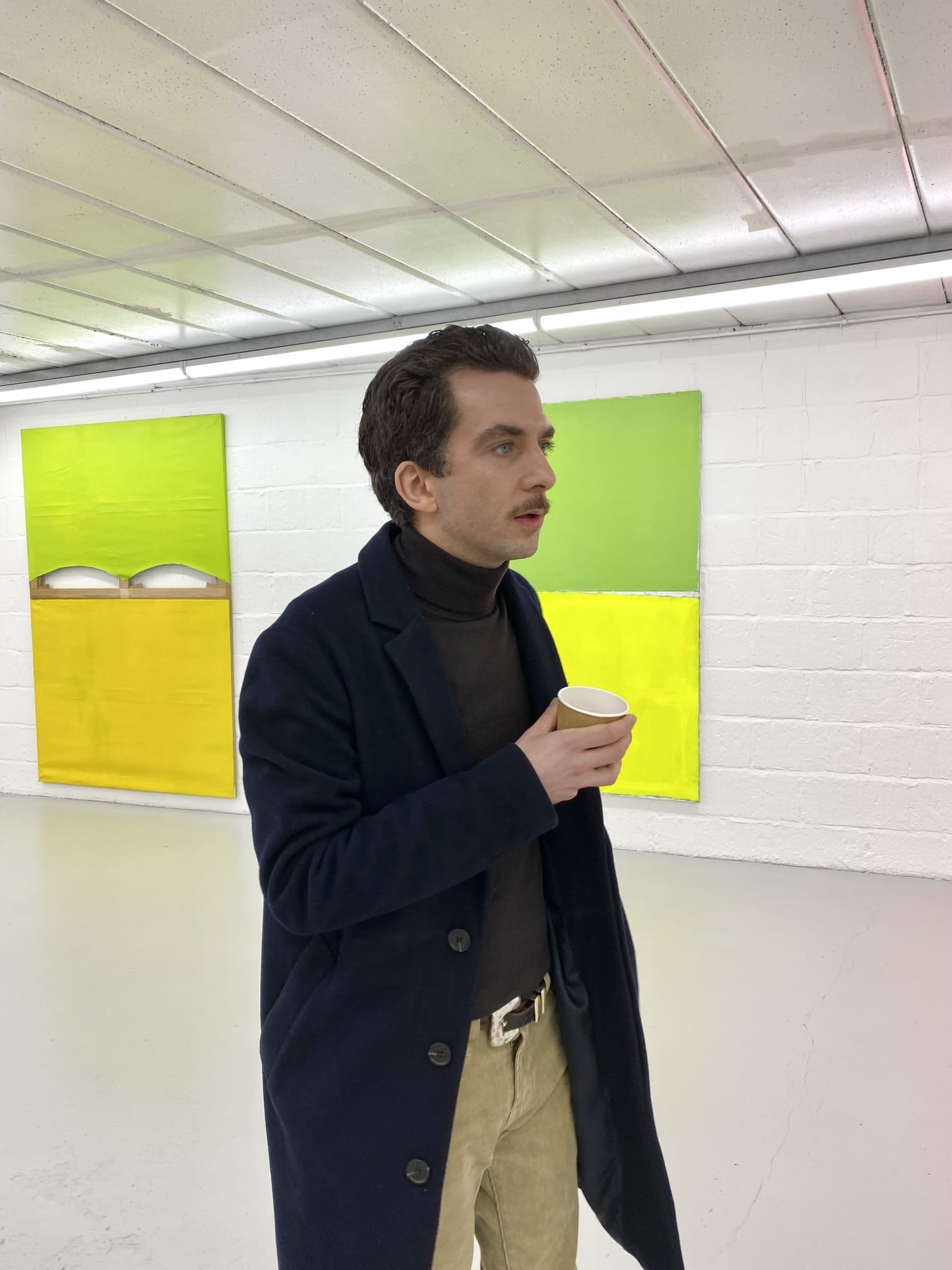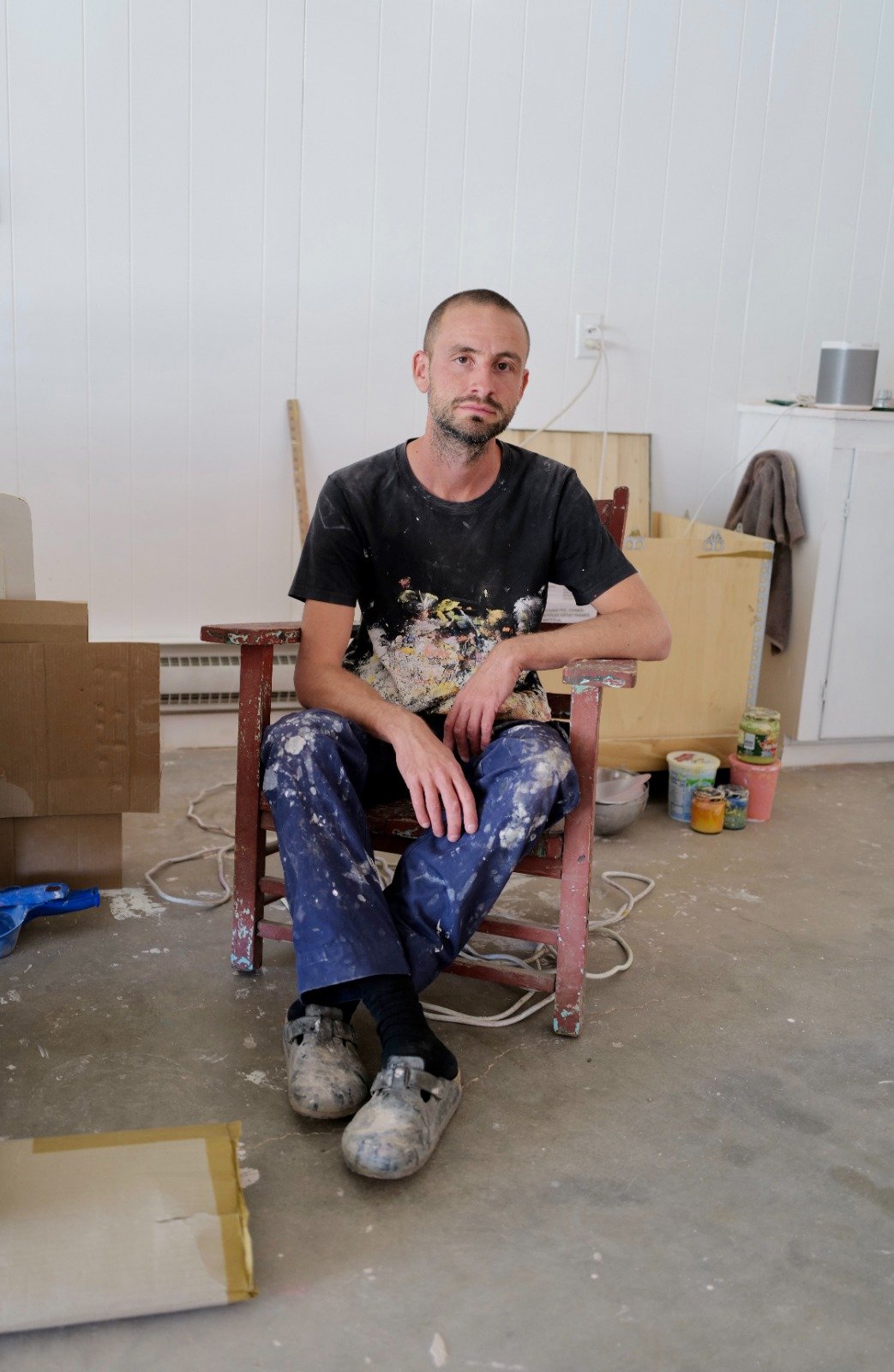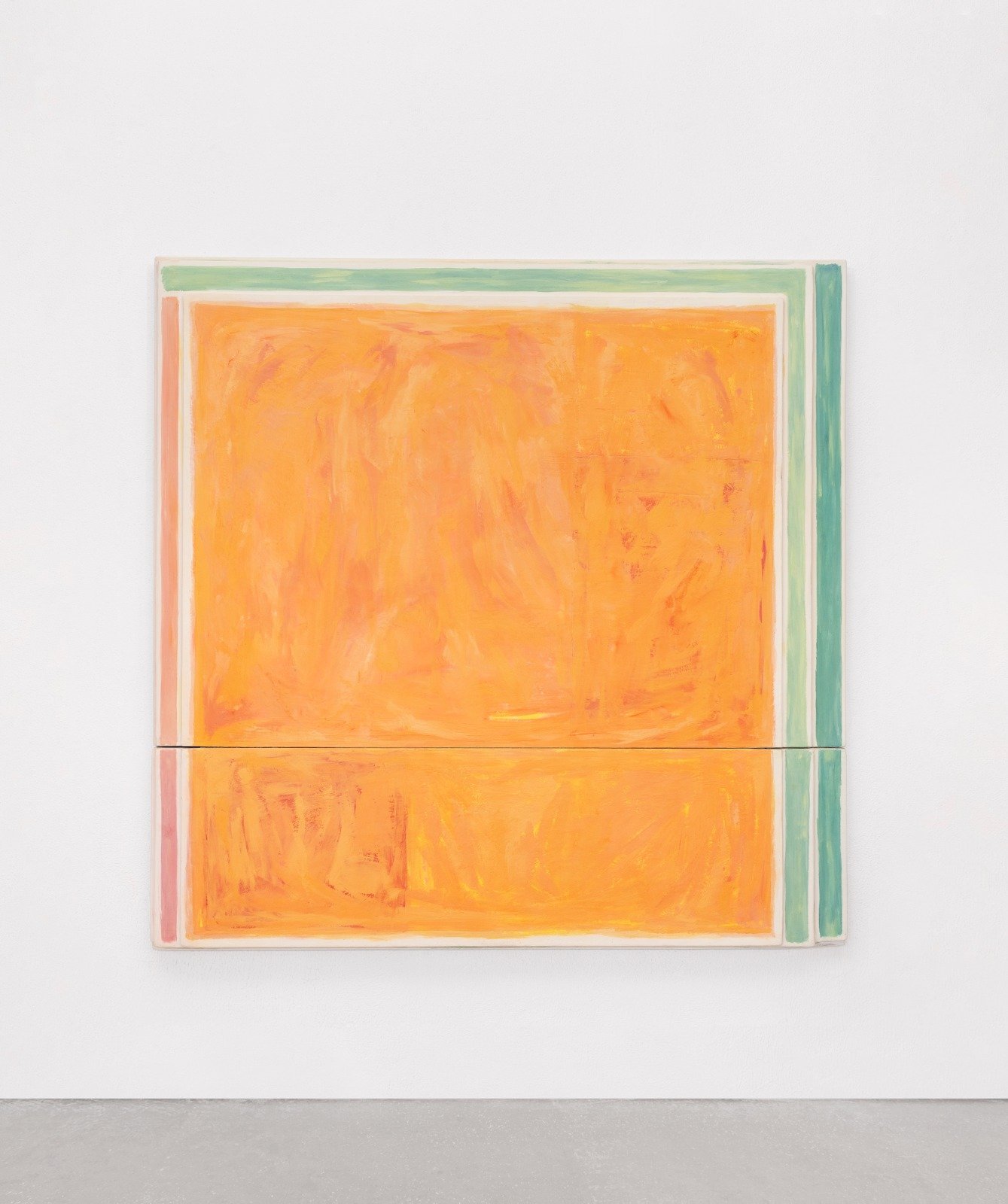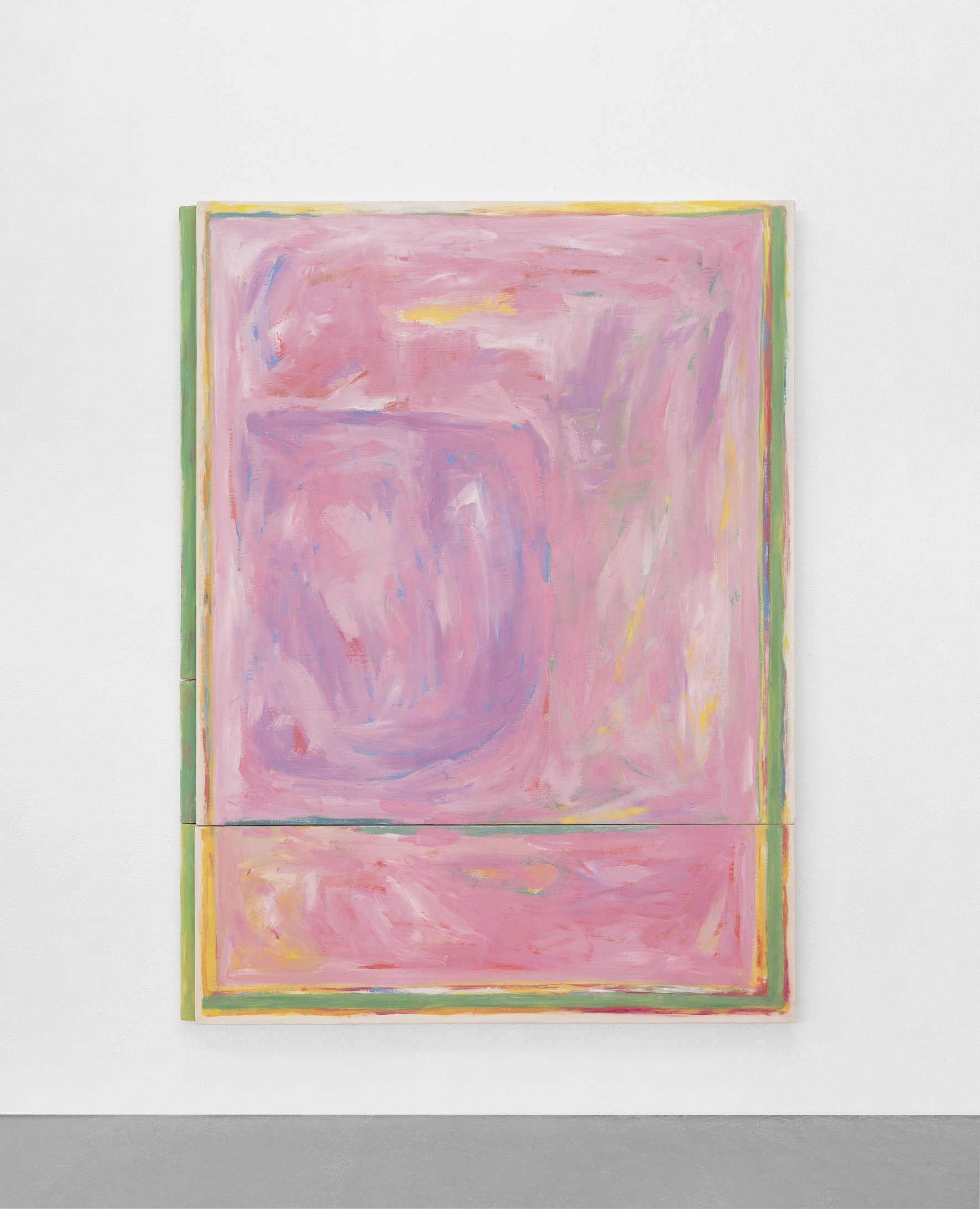‘Paris, Texas’
BOBBY DOWLER | STAN VAN STEENDAM
Opening: Sat. 16 September from 14.00 - 18.00
Exhibition 16/09 - 15/10/2023
(Contact us for a catalog of works or more information)
Bobby Dowler at the opening of his solo show 'Roadworks' at Hannah Barry Gallery, London, UK.
Photo credits Justine White
Barbé Gallery is pleased to present a two-person exhibition of new artworks by Bobby Dowler (UK, 1983) and Stan Van Steendam (BE, 1985). Despite both artists' nomadic movements from one country to another over the years, Bobby’s new works were all conceived and made in Paris, France, whereas Stan’s recent works have been influenced by his recent artistic residency in Texas, USA.
For the last year both artists have been engaged in an ongoing dialogue where they've shared their respective ideas and working practices from which a text is written that is commissioned by Barbé Gallery by the Irish writer Paddy Butler. The exhibition text is written as an homage to Wim Wenders 1983 road movie, Paris, Texas – a slow moving epic that explores one man’s wondering search for resolution/connection amid violent heartbreak.
Stan Van Steendam in his studio during his residence in Marfa, Texas, USA
BOBBY DOWLER, Painting-Object_02 (c09-22), 2022, paint and objects, 150 x 150 x 2.5 cm
Exhibition text by Paddy Butler for the duo exhibition ‘Paris, Texas’:
Wim Wenders 1980s cinematic masterpiece Paris, Texas has become synonymous with the haunting landscape it is born out of. Wenders, being German, perhaps embraced Texas as a means of somewhat decoupling his art from stifling European tradition (Paris the lingering spectre in Paris, Texas). An alternative, new world is presented as a means of artistic recalibration or reinvention – a means of reinvigorating and reframing artistic ambition within a different cultural context. The resulting film is a startling achievement : a slow epic opera of verité cinema. The masterful opening shots of arid desert landscape with humpback escarpments stretching out between monumental outcrops of vertical vaulting rock, immediately invites the viewer to roam free – untaxed by conventions of cinematic narration. This is a generosity of authorial voice, collaboratively welcoming. And throughout the film, the camera is granted precious, unhurried time to reconfigure and suitably frame the enormity of untamed country.
STAN VAN STEENDAM, zeppelin, 2023, varnish, pigments, plaster
and epoxy resin on wood, 117 x 178 x 9 cm
The results are often concentrated in breathtakingly exact compositions of form and light. In many of the innumerable tracking shots it is as if the lens is knitting the seam of horizon right out there before us, tying down interminable far- reaching skies to the quilt of an equally epic wide-open country below (the lone metronomic movement of Travis’ walking legs often reinforcing this with a stitch-like kinetic weave in tandem with the camera’s unerring eye). In this, there is a real sense of innovative pictorial alchemy where a slowing down of cinema allows for an unprecedented framing of landscape and environment : a deeply felt, transformational bond between environment depicted and the material means of its depiction. The alchemical bond of light and celluloid tracing out the terrain with deep contrasting saturations of colour – block-colour parsed, not unlike the dye- transfer prints of that other great documentarian of southern twighlight, William Eggleston.
In their distinct but complimentary ways, both artists in the current show, Paris, Texas, are likewise deeply invested in the material nature of their working environments. Apart from being naturally influenced by the visual aspect of these worlds, incidental materials and found objects might be judiciously appropriated to feed directly into the creation of individual artworks. The current works on show were informed by each artist’s research in, respectively, Texas (Stan) or Paris (Bobby), where again geographical location has fundamentally informed artistic endeavour in both subtle and bold form: where in the extreme, they have sought to break down, traduce and transcend the borders of pictorial representation.
If Wenders enacts a radical slowing of cinema in order to frame and harness vast stretches of landscape, both Stan and Bobby are here engaged in radical methods of ‘de-framing’. This is a sometimes forceful, sometimes lacerating re-presentation of canvas frame as a newly functioning pictorial device. If the frame is traditionally the beginning point of painterly creation, it is here often turned Janus-like, compressed, to be at one and the same time both beginning and ending. Divisively so – as if untamed image has insolently bolted forward into the world only to be hauled back and caged in by bulwark frame.
BOBBY DOWLER, Painting-Object_01 (c09-22), 2022,paint and objects, 236 x 162 x 4 cm
In this foregrounding, this exposure, the frame more often than not acts as a direct visual bridge to our senses rather than mere structural rigging. In Bobby’s works the undergirding scaffold that traditionally harnesses the art becomes, in a literal sense, architectonically expressive – forthright, intrusive, belligerent. Sometimes it is the void of a part-empty frame in Bobby’s work that directs the viewer to another structural dimension : humorously leading the eye to transgress toward a dead end back wall that suspends the work. This has the effect of reframing the narrative according to the site specific presentation of work. In certain works of Stan’s a sudden fault-line breaks straight across the pictorial plane. In others still, a multiplicity of panels are layered to further contest (or accommodate) narrative boundaries, and in the process hint at hidden palimpsests of meaning lying beneath. Related to this is the fact that each newly created work of Stan’s takes inspiration from the work directly preceding it, so that every new piece follows a path containing within it a repository DNA link that is embedded across the entire oeuvre. This serves not only to connect each work in a continous chain, but also determines artistic creativity that is focused on transcending the limits of pictorial borders – here, metaphysical ideas move freely across aesthetic dimensions in much the same way that ideas transcend geographical borders.
STAN VAN STEENDAM, sprinklers, sprinkles, 2023,varnish, pigments, plaster
and epoxy resin on wood, 202 x 152 x 9 cm
At the most basic level the device of foregrounding structure may contest the limits of traditional pictorial boundaries, but it is also to emphasise the material essence of artwork formation and a perhaps spiritual acceptance of the temporal fragility of material representation (which, to this observer, manifests as a beautiful ode to medieval religious art and reliquary). And even if both artists seek to advance the contours of form through ambitious structural change, it is the frame that warrants that experimentation – grants permission to extend or contract the parameters : given pictorial dimensions are dictated by conventional restrictions of stretching and tacking of canvas, or diameter of timber. But here it is more than mere background hoist, and is more bluntly coopted as an auxiliary paintbrush. In this there seems a humorous play on the perennial conundrum every painter must face – where do we go from here? Wender’s answer is the classic road-trip. But by a sleight of hand Bobby adroitly side-steps the matter. The materiality in his ‘orphaned works’ is in part already brought about by the fact that his canvases are found objects, found paintings. Scions of his environment, ‘orphaned’ documentations, which he adopts to refashion – adding and subtracting to the layers of discovery – reframing discarded cultural flotsam, once domestic or public capsules of Paris time. While Stan’s current works incorporate a colour palette that suggest a synthesis of the dry arid landscape ochres with the yellow burning sun they conversely reference the human incursion on the Texan environment, as evinced in his wry, sometimes doubling poetic titles : ‘sprinklers sprinkles’, ‘diesel fried chicken’. All-in-all the narrative device of reframing can be thought of as a playful way to confuse narrative/form and precedent : which comes first, narrative or framing?
The reframing of the landscape through the confines of the angular car window in Wenders’ film serves to sever the viewer from the at once freedom of open desert landscape, while at the same time offering more intimate human nearness (wild country exchanged for supposedly secure civilisation). Through the auto’s windshield, the endless lines of open road trace endless narrative possibilities. But the gravitational pull of narrative necessity eventually forces us into the parallel grooves of one heavenly heartbreaking story, inexorably leading to the final act where the wide open landscape must cede entirely to the small confines of a peep show booth. One that houses a disturbingly resonant one-way mirror framing. This is where both central character must sit and relive their shattered intimate past. A wry acknowledgment that not even the great wide expanse of Texas grants you freedom from your past. In much the same ecstatic way that no purity of picture frame or camera frame grants you escape from traditions of art.
‘PARIS, TEXAS’
Bobby Dowler and Stan Van Steendam
16 Sep. - 15 Oct. 2023
BARBÉ
Penitentenstraat 29
9000 Gent
Belgium
+32 9 391 39 13
desk@barbegallery.be
Open: Thu. - Sun. | 14.00 - 18.00
Outside opening hours by appointment






